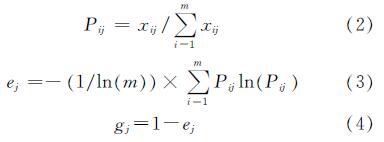基金项目:陕西省公益性地质调查基金项目(202107); 陕西省自然科学基金项目(2019JM-464)
第一作者:王成军(1964—),男,教授,博导,研究方向为资源系统优化、区域资源可持续发展.E-mail:846246702@qq.com.通信作者:赵 丹(1998—),女,硕士,研究方向为资源系统优化、区域资源可持续发展.E-mail:1296973872@qq.com
(1.西安建筑科技大学 管理学院,陕西 西安 710055; 2.陕西省地质调查院,陕西 西安 710054)
(1.School of Management, Xi'an Univ. of Arch. & Tech.,Xi'an 710055,China; 2.Shaanxi Geological Survey, Xi'an 710054,China)
DPSIR theory; coupling coordination model; spatio-temporal evolution; Shaanxi province
DOI: 10.15986/j.1006-7930.2022.03.018
水作为生命赖以生存的物质资源,与人类生活、自然生态息息相关.随着可持续发展理念的提出,水环境作为评价可持续发展的重要内容,因为受到人类社会环境的干扰,存在安全、污染、资源短缺等问题,学者们对于水环境的相关研究有着必要的理论和应用价值.首先在研究内容方面,学者们在水环境承载力[1],水环境治理,水环境安全[2],脆弱性评价[3]等方面进行了研究,也有部分学者就水环境与城镇化[4]、社会经济[5]、旅游活动[6]等进行了系统与系统之间的耦合研究.在研究空间上,学者们从省域[7]、区域[8]、流域[9]以及自然生态区[10]等不同空间层次展开探索.在研究方法上,通过构建指标体系,采用包括熵权模糊综合模型[11]、云模型[12]、主成分分析[13]、层次分析法[14]等不同方法进行测算.在构建评价指标方面,王英刚等[15]构建的指标体系不仅包括了水资源相关,还包括了社会经济和水污染控制相关; 郑博福[16]构建了融合水资源、水环境、水生态、土地生态服务功能等4个维度的水环境承载力评估体系; 曹文平[17]从压力-状态-响应即PSR三个维度进行了指标构建; 万生新等[18]则采用DPSIR即驱动力-压力-状态-影响-响应进行了指标构建,从而对水生态进行安全评价.
纵观现有水环境的研究成果较多,但大都与其他系统进行了耦合,例如与城市化、社会、经济等系统耦合,较为单一; 研究空间上不同层次均有涉猎,但对市域尺度下的耦合协调发展研究相对欠缺; 方法模型各有优劣,对于指标体系的构建则难以形成统一标准.因此,本文的研究意在解决四个关键问题:一是关于评价指标体系的构建研究; 二是评价方法及模型的选择研究; 三是对样本即市域尺度下陕西省的10个地级市展开实例研究; 四是对协调发展状态的影响因素研究.
基于前人研究成果,借助DPSIR模型筛选相关指标因子,构建适用于测度陕西水环境协调发展指标体系,归一化矩阵,并采用熵值法来确定指标权重矩阵.通过综合评价法求得各子系统评价值,运用耦合协调模型计算耦合度、耦合协调度,判断陕西省水环境的协调程度,并采用Arcgis软件绘制时空格局图,进行时空演化分析,最后探究水环境协调的影响因素.
陕西省位于中国中部,地跨黄河、长江两大流域,总面积20.56万m2.长江流域占全省面积35.2%,黄河流域占全省面积64.8%.地理位置上分为陕北、陕南和关中三大区域,包括十大地级市,其中陕北(陕北高原)包括延安市和榆林市,陕南(秦巴山地)包括商洛、安康和汉中,关中(关中平原)包括铜川、渭南、咸阳、宝鸡、西安,以及两个县级市.本文基于数据可获取性,剔除兴平、华阴、韩城这几个县级市,以陕西省的10个地级市为研究对象,分别是西安、铜川、宝鸡、咸阳、渭南、延安、汉中、榆林、安康和商洛.
DPSIR理论源于1993年,由PSR理论与DSR理论扩展而来.为全面反映水环境的系统内影响,本文采用该理论,主要包括5个模块,D代表驱动力,P表示压力、S状态、I影响、R响应.DPSIR理论框架如图1所示,其中,驱动力子系统产生压力,并对其他子系统产生影响,压力与状态子系统互为反哺和恶化关系,状态响应互为改善,响应缓解压力并激励影响子系统,影响子系统补偿响应子系统,五个要素之间互相影响,互为反馈.
驱动力子系统主要为社会经济指标,对水环境无直接的影响,但存在间接的影响,来源于人口和经济指标,包括X1人口自然增长率、X2人均GDP、X3第二产业占 GDP比重和X4地方财政一般预算收入.压力子系统指对水环境整体造成压力的指标,包括4项负效应指标即X5工业用水占比、X6万元GDP用水量、X7工业废水排放总量和X8地表水劣V类水体比例.状态子系统代表水资源的状态和水质状态等,因此,指标选取X9产水模数、X10水土流失面积、X11总耗水量和X12农田灌溉亩均用水量,后三项为逆向指标.影响子系统是指水环境受到的影响,包括X13湿地保护率、X14地表水水质优良比例、X15降水量,前述子系统的改变而引发的影响.响应子系统指人们为了改善治理水环境而做出的努力,包括了X16治理水土保持面积、X17废水治理设施运行费用、X18城市生活污水处理率和X19生态环境用水比重.指标体系如表1所示.
评价指标原始数据主要来源于2004年到2020年的《陕西省统计年鉴》、《中国城市统计年鉴》和《水资源公报》,并参考各地级市统计局数据进行补充,部分指标值通过二次计算得到.由于统计年鉴中人均生产总值2004年以前按照户籍人口计算,2005年以后按照常住人口计算,为避免结果的误差性,最终选择采用2004-2019年的数据,初步构建原始数据表.
由于统计年鉴不同年份数据字段不同,在收集数据时存在缺失值,为弥补信息缺失,需进行缺失值处理,本文参考庞新生[19]做法,采用多重插补缺失值.在软件的选择上,使用了SPSS 22软件,并对插补全的数据进行了标准化处理,基于标准化处理后的数据进行后续的计算模拟分析.评价指标及权重见表1.
指标确权的方法主要分为主观赋权法和客观赋权法,熵值法作为一种客观赋权方法来说,相比较主观赋权法能够消除主观因素的影响,相比较其他客观赋权法计算快速准确.传统的熵值法计算存在不同年份的数据之间不可比的情况,本文采用改进后的熵值法,能够有效避免该问题,即将所有年份的指标同时进行计算,具体操作计算步骤如下:
第一步 标准化处理.对所有原始数据向右平移一个单位,避免因0值无法计算产生的影响,即xij=x'ij+0.001.为了区分正向和逆向指标,标准化的处理公式为

i=1,2,…,m; j=1,2,…,n
式中,x'ij是处理后的标准化值; xij是第i年第j项指标的原始数值; m为年数; n为评价指标个数.
第二步 信息熵和效用值计算

第三步 权重计算

第四步 样本的综合指数计算

Yk是第i年的综合指数,要想得到历年该城市的综合评价值,本文采用时间加权法进行计算,设wt为时间加权系数,则这个城市在该时间内各个系统的总体综合评价值为
Y总=wt×Yk (7)

Y总即评价城市的历年加总后的综合评价指数,该值越大说明城市发展水平越高,越高越好.
为定量计算u1,u2两个不同系统之间的相互作用强度,本文参考王成[20]、邢霞[21]、张文爱的做法[22],借鉴物理学中的容量耦合概念及容量耦合系数模型,则多个系统相互作用耦合度模型为

计算出来的结果Cn越大,则表明n个系统之间的耦合强度越大,相互作用越强烈.本文的指标体系为5个系统,即n=5.
耦合度C值表示了不同系统之间的耦合强弱程度,但不能够反映两者之间的相互作用程度,当两个系统的分值都很高或者都很低的时候,计算出来的耦合度也会很高,那由此得出的结论也不确切. 因此,需要对该模型进行进一步的改进,使模型不仅能够反映系统之间的协调程度,还能够体现出协调水平的高低. 改进的耦合协调模型为:

式中,D为耦合协调度; C为耦合度; T为社会和生态系统的综合发展指数,反映二者的整体效益水平; a、b、c、d、e为待定参数,且满足a+b+c+d+e=1,本文认为社会与生态系统同样重要,假设a=b=c=d=e.耦合协调度D值越大,系统协调发展水平越高.
耦合协调度D值介于0~1之间,该值越大说明系统间协调程度越高; 反之,则越低.对0~1之间的耦合协调度进行等级划分,耦合协调度等级及对应的协调程度划分标准如下表所示:
为进一步直观地体现陕西省水环境协调发展情况,按照时间加权公式将2004年到2019年的数据进行综合计算,分别计算陕西省的综合发展指数、耦合度、耦合协调度,利用ArcGIS10.2软件制作空间分布图,由图2可知,陕西省水环境的综合评价值从0.16上升到0.22,呈上升趋势,耦合度从0.65到0.79,协调耦合度则由0.51的勉强协调达到2019年的0.7也即中级协调,整体均呈现上升趋势,且整体高耦合中度协调,稳中有进,态势良好.全省总体维持在0.05~0.3的区间内,全省的水环境在过去16年间整体达到勉强协调程度以上状态,从2004年到2019年,16年间跨越了3个阶段,驱动力-压力-状态-影响-响应各子系统之间也高度耦合,在2011年达到峰值最高耦合度达到0.841,后面下降并趋于稳定.
分析模型计算结果,在2012年各市均处于一个波谷,究其原因是各市的响应子系统均有不同程度的降低,尤其铜川在这一年的响应子系统得分降低了80%; 西安市则在2010年达到峰值0.256 3,源于响应子系统的增加值; 榆林市和延安市2011年的综合评价值急速增加也同理.
如表3所示,该数据反映了2004—2019年的协调耦合程度的时间序列变化,局部较波动,整体呈上升趋势,但个别存在回落状况,然后再趋于稳定.分析各市的协调耦合度榆林市最高,协调程度从濒临失调到良好协调,从最初的0.451到0.825,跨越了5个阶段; 铜川市协调程度最弱,虽有波动但整体仍然维持在濒临失调,在2011年达到了最高初级协调.仅有榆林市和宝鸡市在2019年达到了良好协调,表明了该时水环境的协调状况优于其他各市.
图2 2004—2019陕西省水环境DPSIR系统耦合度、协调度与综合评价值时序变化
Fig.2 Time series changes of coupling degree, coordination degree and comprehensive evaluation value of water environment DPSIR system in Shaanxi Province from 2004 to 2019
通过ArcGIS 10.2软件绘制如图5所示的陕西省综合发展指数(左)、耦合度(中)、耦合协调度(右)时空格局图.从综合评价值来看,陕西基本上分为两个区域,一个区域综合评价值较高在0.2~0.25区间,包括除了渭南以外的关中地区和汉中、商洛,另一个区域的综合评级在0.15~0.2之间,包括陕北地区及渭南、安康市.从耦合度来看,则较为分散,西安市的耦合度最低,居于中间,延安市耦合度最高.从协调耦合度来看,同耦合度的分布类似.整体来看,西安市作为陕西省会城市,其水环境协调发展程度与其经济发展程度不成正比.
为更加细致刻画出陕西省内部10个城市的水环境DPSIR系统耦合度指数之间的对比,自2004—2019年隔5年为代表,通过ArcGIS 10.2软件绘制如图4所示2004年、2009年、2014年和2019年的耦合度时空格局图.2004年、2009年、2014年和2019年陕北区域的社会生态耦合度指数分别为0.726、0.686、0.927、0.96,陕南区域的耦合度分别为0.551、0.652、0.678、0.929,关中一带的耦合度分别为0.682、0.668、0.689、0.772.可以看出,计算期间内陕西省水环境耦合度指数陕北陕南地区的耦合度高于关中地区,整体呈现上重下轻状,表现为陕南陕北地区水环境DPSIR系统之间的关联性高于关中地区,关中地区水环境各系统之间的紧密结合性有待增强.
图3 陕西省综合时空格局图
Fig.3 The spatial and temporal pattern of the comprehensive development index(left), coupling degree(middle), and coupling coordination degree(right)of Shaanxi Province
图4 2004、2009、2014、2019年耦合度时空格局图
Fig.4 The spatiotemporal pattern of coupling degree in 2004, 2009, 2014 and 2019
为进一步探讨陕西省内不同地区的协调发展状况.一方面从时序变化上看,2004年、2009年、2014年和2019年陕北地区耦合协调度指数分别0.513 5、0.553 5、0.702 5和0.787,陕南地区分别为0.514 3、0.556 7、0.625 3和0.657 7,关中地带协调指数为0.518 4、0.542 2、0.591 2和0.690 6,陕西省的整体耦合协调度分别为0.516 2、0.548 8、0.623 7和0.7,2004年—2019年陕西省水环境的协调度指数较低,16年间仅跨越了3个阶段,且协调水平仍然较低.另一方面从空间变化上,通过图5时空格局图可将陕西分为三个层次的城市地区,第一个层次为延安、榆林、西安和宝鸡,2019年均达到了中级或良好协调状态; 第二层次为咸阳、渭南、商洛、安康和汉中市; 第三层次为铜川市,变化较慢,2019年仍处于濒临失调阶段.
为更好地解释陕西省耦合协调度时空变化差异,从而制定更加有效的策略,本文参考国内学者钱丽[23]等的方法,采用面板模型检验耦合协调度的影响因素.以指标体系中的19个变量作为解释变量,以耦合协调度值作为被解释变量进行面板模型构建.首先对面板模型面板的涉及3个模型即混合POOL模型、固定效应FE模型和随机效应RE模型进行模型检验,便于找出最优模型,计算结果如表4所示:F检验呈现出5%水平的显著性F(9,22)=12.759,p=0.000<0.05,意味着相对POOL模型而言,FE模型更优.BP检验并未呈现出显著性chi(1)=0.122,p=0.364>0.05,意味着相对RE模型而言,POOL模型更优.Hausman检验并未呈现出显著性chi(18)=nan,p=nan>0.05,意味着相对FE模型而言,RE模型更优.综上分析,本文最终以FE模型作为最终结果.
如表5可知,对耦合协调度指数具有显著影响的因素分别有:(1)就人口自然增长率而言,其呈现出0.05水平的显著性(t=2.401,p=0.025<0.05),并且回归系数值为0.008>0,说明人口自然增长率对耦合协调度值会产生显著的正向影响关系.(2)针对万元GDP用水量而言,其呈现出0.01水平的显著性(t=-4.968,p=0.000<0.01),并且回归系数值为-0.000<0,说明万元GDP用水量对耦合协调度值会产生显著的负向影响关系.(3)针对湿地保护率而言,其呈现出0.05水平的显著性(t=2.334,p=0.029<0.05),并且回归系数值为0.001>0,说明湿地保护率对耦合协调度值会产生显著的正向影响关系.(4)针对地表水水质优良(达到或好于III类)比例而言,其呈现出0.01水平的显著性(t=3.294,p=0.003<0.01),并且回归系数值为0.001>0,说明地表水水质优良(达到或好于III类)比例对耦合协调度值会产生显著的正向影响关系.
通过构建陕西省水环境协调发展的评价指标体系,采用熵值法和耦合度模型,对2004—2019年陕西省的数据进行了测算,计算出陕西省各个市历年的综合发展指数、耦合度、耦合协调度,并对测算结果进行了时间和空间上的对比分析.整体来看,陕西省水环境协调发展水平呈不断上升趋势,前7年维持在勉强失调,于2011转为初级失调,2019年提高到中级协调,这中间跨越了3个不同的阶段,整体趋势虽不断提高,但离良好协调状态差距仍然较大,有待进一步提升.从时间发展来看,陕西省各个城市的协调程度呈上升趋势,除铜川市外,其他9个城市最终都达到了协调程度,但仍距良好协调存在较大距离,达到优良的协调程度离不开水环境内部系统两两之间正向反馈作用,水环境的协调发展要同步社会经济发展进行,驱动力与压力之间促进,影响状态、影响、响应系统,互为正反馈,一个也不能落下.从空间分布上来看,陕南陕北的协调程度高于关中地区,铜川的协调程度最差.
最后,采用面板模型进行分析发现,对耦合协调度具有显著影响的主要因素有四个,分别是人口自然增长率、万元GDP用水量、湿地保护率和地表水水质优良比例.通过对这四项显著影响因素的分析探讨,在政策建议方面,本文针对陕西省现有水环境协调状态,提出四个方面的建议,以期对陕西省水环境协调状况的改善提供借鉴意义.一是完善水环境治理体系法律法规建设,强化监督; 二是人口宏观政策的调控; 三是加强环境治理,进一步增强生态治理,全面降低水污染; 四是就省内各地区不同地理位置发挥其优势,合理规划城市空间,协同发展,均衡治理.